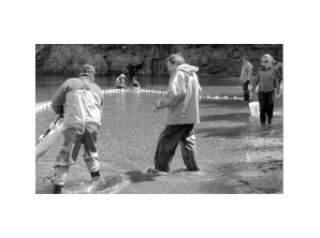Abundant numbers of young salmon are using our local beaches and shorelines for food and shelter, confirming that the San Juans play a critical role in the recovery of Puget Sound salmon. Those were the findings of leading fishery experts gathered at a Salmon Recovery Technical Workshop held January 26 and 27 at the University of Washington Friday Harbor Labs.
Eighty scientists, state and federal government agency staff, stewardship group members, tribal representatives, local project sponsors and interested citizens gathered to hear presentations on recent research and projects related to salmon health. The workshop was organized by Barbara Rosenkotter, San Juan County Salmon Recovery Coordinator. She noted that “San Juan County is on the cutting edge of salmon recovery and I’m thrilled that many people came from all over the Sound to hear about our recent project results. Great science is answering some important questions about salmon usage of the nearshore, specifically in the San Juans, and local scientists are leading much of the research.”
A comprehensive set of studies conducted by Eric Beamer, Skagit River System Cooperative and Kurt Fresh and David Teel of National Oceanic and Atmospheric Administration (NOAA) Fisheries evaluated juvenile salmon in the islands. They set out to find out when and how long young salmon are here each year and what habitats they prefer.
By evaluating fish gathered by beach seining and tow nets, they found that shoreline habitats are providing nursery habitat to a wide variety of fish species, including juvenile salmon, forage fish, and others (greenling, lingcod, true cods, and flatfish ). They also found that juvenile salmon were present in all months, in all regions, and in all shoreline types, though more numerous in pocket beaches, bluff-backed beaches, barrier beaches and pocket estuaries, and also more numerous on the islands’ outer perimeters. Farther offshore the researchers found an abundance of forage fishes, particularly herring and sand lance. These fish were quite abundant compared with the numbers found in similar studies in other areas of the Puget Sound. Forage fishes are known to provide an essential food supply for salmon, marine birds, and marine mammals in the San Juan Islands.
Another study, conducted by David Teel and Kurt Fresh of NOAA Fisheries and David Kuligowski and Eric Beamer of the Skagit River System Cooperative, worked to identify where (what stock or river system) these juvenile salmon come from. Using a suite of genetic testing techniques, they analyzed fish from around the islands. The study determined that the San Juan Islands nearshore marine habitats are used by juvenile salmon from a wide variety of stocks originating in British Columbia and Washington rivers. Researcher David Teel commented that this is the highest diversity of salmon stocks that he has seen in his studies throughout Puget Sound.
A fascinating study by Kwiaht, a research organization based on Lopez Island, sought to identify what juvenile Chinook salmon eat while they are in the nearshore waters of the county. By examining the stomach contents of sample fish, the researchers found a surprising reliance on fresh water insects that originate on land and fresh water. More than half of the prey items, by number, were insects. Crustaceans and forage fish represent the majority of prey items by weight, but insects constitute a significant portion at nearly 25%.
Russel Barsh, who presented this study, offered that “while marine environments may provide the highest-value prey items, terrestrial habitats including wetlands, streams, and riparian vegetation supply an important source of late-summer nutrition for juvenile Chinook.”
Summing up the workshop findings, Kim Sundberg, chair of the local salmon recovery technical advisory group, noted the “large biomass of forage fishes (herring, sand lance and smelt) in nearshore waters around San Juans is one of the reasons for the importance of the area for health of regional salmon populations. This could bode well for recovery of salmon, and other fish, as well as marine birds and certain cetaceans, such as minke whales and porpoise. Recovery of healthy salmon populations, especially Chinook, are also key to the recovery of our resident Orca whales. It clearly shows the need to protect forage fish spawning beaches and nearshore rearing areas.”
For further information, please contact Barbara Rosenkotter, San Juan County Salmon Recovery Lead Entity Coordinator, 360-370-7593 or barbarar@sanjuanco.com



